|
Featured picture tools: |
These featured pictures, as scheduled below, appeared as the picture of the day (POTD) on the English Wikipedia's Main Page in December 2014. Individual sections for each day on this page can be linked to with the day number as the anchor name (e.g. [[Wikipedia:Picture of the day/December 2014#1]] for December 1).
You can add an automatically updating POTD template to your user page using {{Pic of the day}} (version with blurb) or {{POTD}} (version without blurb). For instructions on how to make custom POTD layouts, see Wikipedia:Picture of the day.Purge server cache
December 1

|
Five views of the shell of the veined rapa whelk (Rapana venosa), a species of large predatory sea snail in the family Muricidae. The species' shell is rounded and heavy, possessing a very short spire, a large body whorl, a strong, orange columella and a deep umbilicus. The aperture is a deep orange, large, and roughly ovate. On the outside, the shell color varies from gray to reddish-brown, with dark brown dashes on the spiral ribs. Photograph: H. Zell
Recently featured:
|
December 2

|
A Buller's albatross (Thalassarche bulleri) in flight, with a short-tailed shearwater behind it, as photographed east of the Tasman Peninsula, Tasmania, Australia. This small mollymawk species, named for the ornithologist Walter Buller, breeds on islands around New Zealand. It is classified as near threatened, though the population is increasing. Photograph: JJ Harrison
Recently featured:
|
December 3
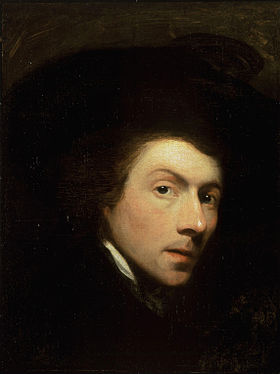
|
A self-portrait of Gilbert Stuart (1755–1828) completed c. 1778, when the artist was in his early 20s. Born in Saunderstown, Rhode Island, Stuart began studying painting at a young age. He studied art in Scotland under Cosmo Alexander, and in England during the American Revolution under Benjamin West. By the time he completed this self-portrait, Stuart's works had already been exhibited at the Royal Academy of Arts. Stuart returned to the United States in 1791, and went on to paint several presidential portraits – including one of George Washington which has been used on the one-dollar bill for over a century. Painting: Gilbert Stuart
Recently featured:
|
December 4

|
|
The Guyou hemisphere-in-a-square projection is a map projection used to project a hemisphere. It is conformal everywhere except for the four corners of each hemisphere's square. This projection, developed by Émile Guyou in 1887, can be considered an oblique aspect of the Peirce quincuncial projection, with which it has numerous similarities. The imagery used for the map is a derivative of NASA's Blue Marble summer months composite, with oceans lightened to enhance legibility and contrast. Map: Strebe, using Geocart
Recently featured:
|
December 5

|
The steenbok (Raphicerus campestris) is a species of small antelope, generally standing 45–60 centimeters (16–24 inches) at the shoulder, commonly found in Africa. They live in a variety of habitats, from semi-desert to open woodland and thickets, and feed on low-level vegetation and roots. These common animals are typically solitary, except during mating season. Photograph: Yathin S Krishnappa
Recently featured:
|
December 6

|
|
The Grose Valley is a rugged valley in the Blue Mountains, New South Wales, Australia, which was formed by the Grose River. The valley is located between the Great Western Highway and Bells Line of Road, the two major routes across the Blue Mountains. Most of the valley falls within the Blue Mountains National Park. On the right side of the image, the Bridal Veil Falls are visible. Photograph: David Iliff
Recently featured:
|
December 7

|
The East Brother Island Lighthouse is a lighthouse located on East Brother Island, near the tip of Point San Pablo in Richmond, California. This lighthouse was designed by Paul J. Pelz and completed in 1874, then operated manually until 1969. After the light was automated, the former keeper's house was converted into a bed and breakfast; the island is now a tourist attraction. Photograph: Frank Schulenburg
Recently featured:
|
December 8

|
Correa alba is a shrub endemic to Australia. Reaching some 1.5 metres (4 ft 11 in) in height, this shrub is a hardy species in well-drained situations. The ovate leaves measure 1.5 to 3.5 centimetres (0.59 to 1.38 in) long and 1 to 2.7 centimetres (0.39 to 1.06 in) wide. The flowers, as shown here, are generally white, but may also be light pink. They usually appear between mid-autumn and early winter. Photograph: JJ Harrison
Recently featured:
|
December 9

|
Aurora Borealis is an oil painting on canvas completed by Frederic Edwin Church in 1865 and now held in the Smithsonian American Art Museum. It depicts the northern lights and the Arctic expedition of Dr. Isaac Hayes – a pupil of Church's – and first exhibited in 1865. The painting has been considered to depict the portent of a simultaneously triumphant and desolate Union victory, and been associated with Church's Rainy Season in the Tropics (1866). Painting: Frederic Edwin Church
Recently featured:
|
December 10
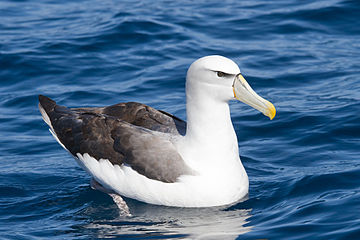
|
The shy albatross (Thalassarche cauta) is a medium-sized albatross, averaging 90 to 99 centimetres (35–39 in) in length with a 220–256 cm (87–101 in) wingspan. It breeds on rocky islands off the coasts of Australia and New Zealand, but non-breeding birds can be found throughout the southern oceans. The shy albatross feeds on fish, cephalopods, crustacea, and tunicates; it has been known to dive to depths of 5 m (16 ft) in search of prey. Photograph: JJ Harrison
Recently featured:
|
December 11
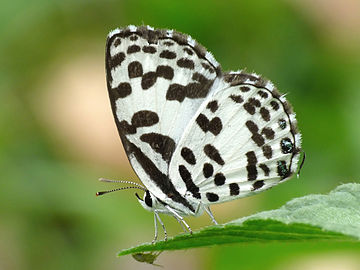
|
Castalius rosimon is a small butterfly in the family Lycaenidae. First described by Johan Christian Fabricius in 1775, the species can be found in South and Southeast Asia. Photograph: Jeevan Jose
Recently featured:
|
December 12

|
American astronomer Percival Lowell at his observatory in Flagstaff, Arizona. In this 1914 photograph Lowell is seen observing Venus high in the daytime sky, with the refracting telescope's 24-inch (61 cm) lens diameter stopped down to 3 inches (7.6 cm) to reduce the effects of atmospheric turbulence. Lowell has been described as "the most influential popularizer of planetary science in America before Carl Sagan". His efforts to find Planet X eventually led to the discovery of Pluto, 14 years after his death. Pluto was named partly in recognition of Lowell's efforts, although the Planet X theory was subsequently disproved. Photograph: Unknown; Restoration: Joe Haythornthwaite
Recently featured:
|
December 13

|
Maria Anna (1606–46) was the youngest daughter of King Philip III of Spain and Margaret of Austria. A marriage planned for her in the 1620s to the future Charles I of England, a Protestant, did not take place as she was Catholic and neither one wanted to convert. Instead, in 1631 Maria Anna married the Holy Roman Emperor, Ferdinand III. Theirs was reportedly a happy marriage, and as Holy Roman Empress Maria Anna was politically active. This portrait was completed by Diego Velázquez in 1630, a year before Maria Anna's wedding. Painting: Diego Velázquez
Recently featured:
|
December 14

|
An aerial view of Masada, an ancient fortification in the Southern District of Israel. Found atop an isolated rock plateau, it overlooks the Dead Sea. The first fortifications on the mountain were built by Alexander Jannaeus, and significantly strengthened by the Roman client king Herod between 37 and 31 BCE. During the First Jewish–Roman War of 66–73 CE, the fortress was besieged, falling only after the 960 Sicarii defending it committed mass suicide. Masada is among the more popular tourist attractions in Israel, and in 2001 it was made a UNESCO World Heritage Site. Photograph: Andrew Shiva
Recently featured:
|
December 15

|
|
An aerial view of Manhattan in 1873, with Battery Park in the foreground and the Brooklyn Bridge under construction at the right. After the American Civil War concluded in 1865, New York saw an influx in immigration from European countries looking for a new life in the United States. However, the squalid conditions and low wages allowed these immigrant communities to become hotbeds of revolutionary ideas. Engraving: George Schlegel; restoration: Adam Cuerden
Recently featured:
|
December 16

|
Eristalinus megacephalus is a species of hoverfly which can be found in non-marine areas of numerous countries in Africa, Europe, and Asia. First described by Pietro Rossi in 1794, its name emphasizes the size of its head. E. megacephalus, which averages 8–11 millimetres (0.31–0.43 in) in length, uses Batesian mimicry to resemble a bee or other hymenopteran and thus scare away predators. Photograph: Muhammad Mahdi Karim
Recently featured:
|
December 17

|
A sketch of the facade of the Saint-Augustin Church in Paris, by its architect Victor Baltard. Born to architect Louis-Pierre Baltard in 1805, Baltard began winning prizes for his architecture by 1833. In 1849 he was made Architect of the City of Paris, and in this position he designed several buildings, including Les Halles and the Notre-Dame-des-Blancs-Manteaux Church as well as this church. Before his death in 1874, he also restored several churches, including Saint-Étienne-du-Mont and Saint-Paul-Saint-Louis. Drawing: Victor Baltard
Recently featured:
|
December 18
Subpage 1

|
The 1928 series of United States Note, the first small-size banknotes issued in the United States. The $2 and $5 bills in this series, which replaced the large-sized notes that had been used since the Civil War, were introduced in 1929, though $1 notes were issued in 1933 in response to the Great Depression. The obverses of these bills were similar to contemporary Federal Reserve Notes, but can be readily differentiated by their red (not green) U.S. Treasury Seals and serial numbers. This set of three images from the National Numismatic Collection at the National Museum of American History show the first $1, $2, and $5 notes printed. Each has the serial number A00000001A. Banknote: Bureau of Engraving and Printing (image courtesy of the National Numismatic Collection, National Museum of American History)
Recently featured:
|
Subpage 2
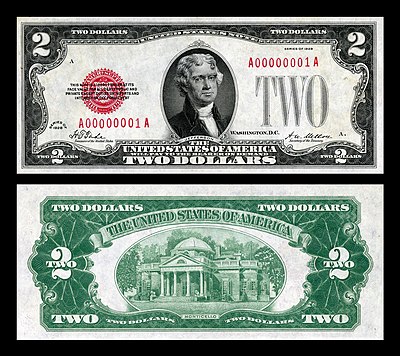
|
The 1928 series of United States Note, the first small-size banknotes issued in the United States. The $2 and $5 bills in this series, which replaced the large-sized notes that had been used since the Civil War, were introduced in 1929, though $1 notes were issued in 1933 in response to the Great Depression. The obverses of these bills were similar to contemporary Federal Reserve Notes, but can be readily differentiated by their red (not green) U.S. Treasury Seals and serial numbers. This set of three images from the National Numismatic Collection at the National Museum of American History show the first $1, $2, and $5 notes printed. Each has the serial number A00000001A. Banknote: Bureau of Engraving and Printing (image courtesy of the National Numismatic Collection, National Museum of American History)
Recently featured:
|
Subpage 3

|
The 1928 series of United States Note, the first small-size banknotes issued in the United States. The $2 and $5 bills in this series, which replaced the large-sized notes that had been used since the Civil War, were introduced in 1929, though $1 notes were issued in 1933 in response to the Great Depression. The obverses of these bills were similar to contemporary Federal Reserve Notes, but can be readily differentiated by their red (not green) U.S. Treasury Seals and serial numbers. This set of three images from the National Numismatic Collection at the National Museum of American History show the first $1, $2, and $5 notes printed. Each has the serial number A00000001A. Banknote: Bureau of Engraving and Printing (image courtesy of the National Numismatic Collection, National Museum of American History)
Recently featured:
|
December 19

|
The striated pardalote (Pardalotus striatus) is a passerine bird found in Australia. The most common pardalote species, it was first described by Johann Friedrich Gmelin in 1789. Although plumage varies, the nominate subspecies (as shown here) is identifiable by a yellow spot on the wing. Photograph: JJ Harrison
Recently featured:
|
December 20

|
A portrait of a male impala, showing its horns. Horns consist of bone cores surrounded by a covering of keratin and other proteins, and are often curved or spiral in shape. Most horned animal species have one pair, though some may have more. Photograph: Muhammad Mahdi Karim
Recently featured:
|
December 21

|
Julie Delpy (born 1969) is a French-American actress and film director. In 1990 she found success with Europa Europa, portraying a pro-Nazi girl who falls in love with a youth she does not know is Jewish. Shortly afterwards Delpy moved to the United States, acting in Hollywood productions such as Before Sunrise and An American Werewolf in Paris and studying filmmaking at the Tisch School of the Arts. This picture was taken in 1991. Photograph: Fabrice Lévêque
Recently featured:
|
December 22
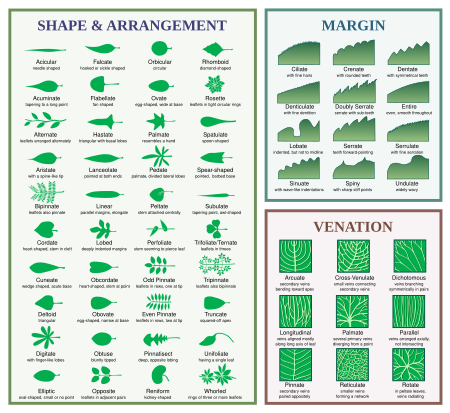
|
|
A diagram showing different characteristics of leaves which are visible to the naked eye or under slight magnification. These can be used for identifying the species on which the leaves are found. This chart shows three aspects of leaves that can be differentiated: the shape and arrangement of the leaf, its edge (or margin), and the pattern of its veins.
Recently featured:
|
December 23

|
Hotel Astoria is a five-star hotel located on Saint Isaac's Square in Saint Petersburg. Commissioned in 1910 by the Palace Hotel Company to host visitors to the Romanov tercentenary, the hotel was designed by Fyodor Lidval and first opened in 1912. After the October Revolution, it continued to be used as a state-operated hotel, though during World War II it was also a field hospital. The hotel, now owned by Rocco Forte Hotels, has been renovated several times, most recently in 2012. Photograph: Florstein
Recently featured:
|
December 24

|
A Yule log cake made of chocolate sponge cake, filled with raspberry jam, and decorated to resemble its namesake. Such cakes, known as bûche de Noël in French, are traditional desserts served near Christmas in France and several of its former colonies. Photograph: Jebulon
Recently featured:
|
December 25

|
|
The Christmas truce was a series of unofficial truces between British and German forces which occurred along the Western Front of World War I around Christmas 1914. In the week leading up to Christmas, soldiers exchanged seasonal greetings and songs between their trenches. On Christmas Eve and Christmas Day, many soldiers from both sides independently ventured into "no man's land" between the lines. There they mingled, exchanged food and souvenirs, and on several occasions held joint burial ceremonies and carol-singing. Troops from both sides were also friendly enough to play games of football with one another. Although fighting continued to take place in some places, the truce is often considered a symbolic moment of peace and humanity amidst one of the most violent events of human history. However, the high commanders on both sides saw it as insubordination, and it was not repeated after 1914. Illustration: A. C. Michael, The Illustrated London News
Recently featured:
|
December 26

|
Blackness Castle is a fortress located on the south shore of the Firth of Forth near Blackness, Scotland. Built by Sir George Crichton in the 1440s, the castle passed to King James II of Scotland in 1453. During its more than 500 years as crown property, the castle has served as a prison, artillery fortification, and ammunition depot. The castle is now a Scheduled Ancient Monument, in the care of Historic Scotland. Photograph: John Wells
Recently featured:
|
December 27

|
The lesser sand plover (Charadrius mongolus) is a small, highly migratory wader in the plover family of birds. It feeds predominantly on insects, crustaceans and annelid worms. Photograph: JJ Harrison
Recently featured:
|
December 28
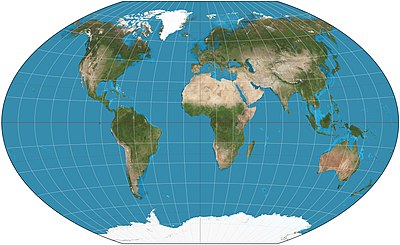
|
The Winkel tripel projection is a modified azimuthal map projection proposed by Oswald Winkel in 1921. The arithmetic mean of the equirectangular projection and the Aitoff projection, it was intended as a compromise between minimizing three kinds of distortion: area, direction and distance. The imagery used for the map is derived from NASA's Blue Marble summer months composite, with oceans lightened to enhance legibility and contrast. Map: Strebe, using Geocart
Recently featured:
|
December 29

|
|
Makhtesh Ramon, a cirque measuring 40 kilometres (25 mi) long, 2–10 kilometres (1.2–6.2 mi) wide, and 500 metres (1,600 ft) deep, is the world's largest makhtesh. It is located in Israel's Negev desert, some 85 kilometres (53 mi) south of Beersheba. The makhtesh and surrounding area are home to only one settlement, Mitzpe Ramon, and together form Israel's largest national park. Photograph: Andrew Shiva
Recently featured:
|
December 30

|
|
The Half Dome is a granite dome in California's Yosemite National Park, whose summit at elevation 8,844 ft (2,696 m) is more than 4,700 ft (1,400 m)Error in convert: Ignored invalid option "digits=2" (help) above the floor of Yosemite Valley. Known to the local Native Americans as "Tis-sa-ack", the dome was first summitted by George G. Anderson in October 1875. It is now widely ascended, with more than 50,000 people a year climbing the class 3 "Cable Route". Photograph: David Iliff
Recently featured:
|
December 31

|
A mid-19th century illustration for "Auld Lang Syne", a Scots poem written by Robert Burns in 1788 and set to a traditional melody. It is traditionally used in the English-speaking world to bid farewell to the old year at the stroke of midnight on New Year's Eve; this has led to the song being used to close other activities as well. Engraving: John Masey Wright (artist) and John Rogers (engraver); restoration: Adam Cuerden
Recently featured:
|
Picture of the day archives and future dates